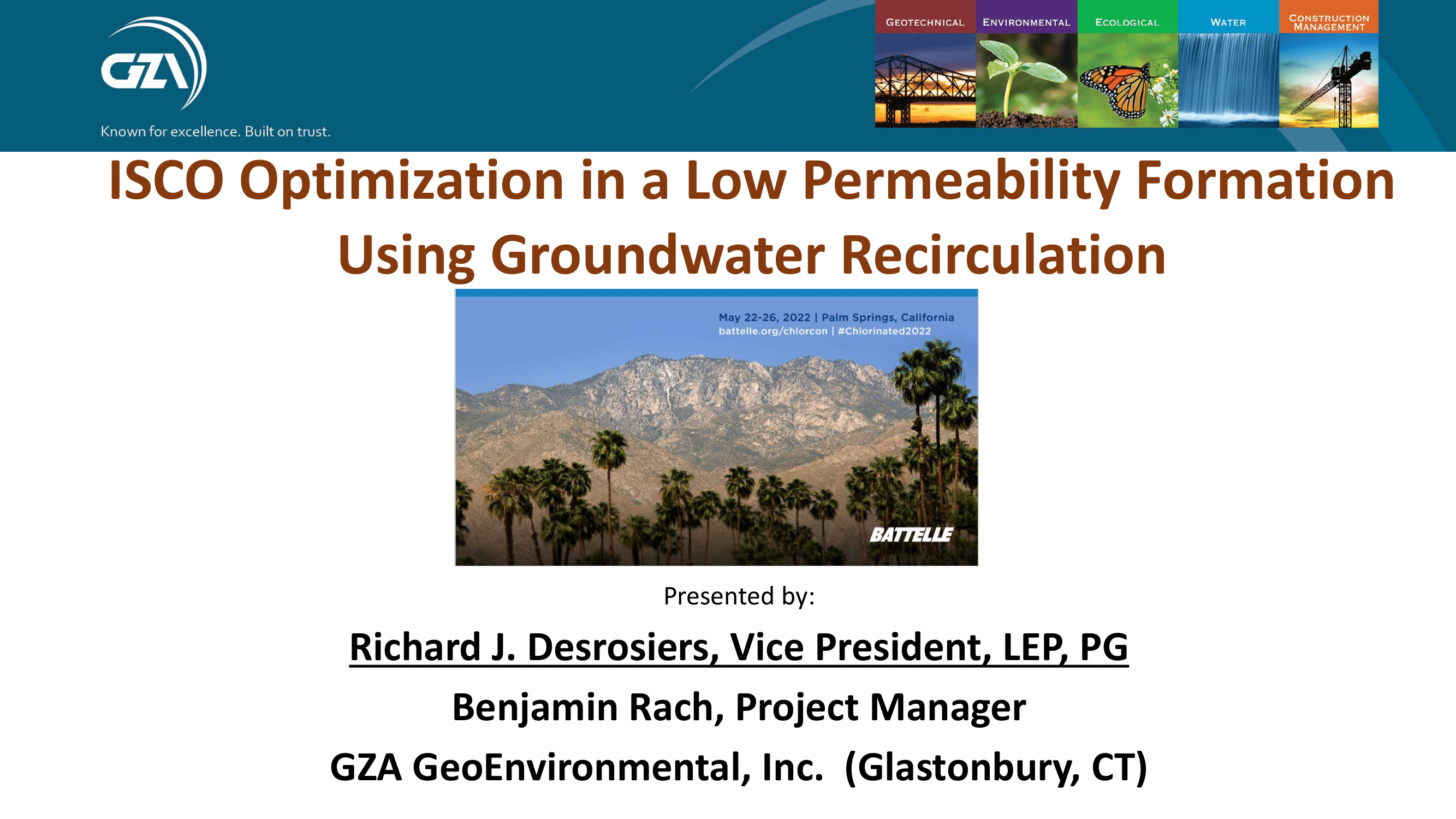Insights
ISCO Optimization in a Low Permeability Formation using Groundwater Recirculation
At a Glance
Background/Objectives
Historical chlorinated solvents (cVOC) were released during the period of the mid-1950 through mid-1990’s resulted in contamination of low permeable glacial fluvial and deltaic lobe deposits (fine sand, silt and ¼ to 2” desiccated clays). The cVOC release (TCE = 6- to 10 mg/L) was located on a hydraulic divide which bifurcated the cVOCs into three distinct 200-foot-wide plumes that discharge 3,500 feet downgradient, to adjacent wetland. Given maturity of the plumes, the greatest mass is present in the fine sand unit; however, significant mass was sorbed into the lower permeable units.
To remediate these 3,500-foot-long plumes to meet drinking water quality, would be cost prohibitive. Therefore, a state negotiated remedy was designed to target the removal of those contaminant zones with the greatest mass using chemical oxidants followed by a long-term groundwater MNA program. Two rounds of direct ISCO injections were completed over a 10-acrea area targeting the fine-grained sand and silt units to reduce mass concentration to less than 500 µg/L followed by MNA. The direct injections were very effective (90 to 99%) in the fine sand units; however, less effective (35 to 60%) in the lower permeable units.
To remediate these 3,500-foot-long plumes to meet drinking water quality, would be cost prohibitive. Therefore, a state negotiated remedy was designed to target the removal of those contaminant zones with the greatest mass using chemical oxidants followed by a long-term groundwater MNA program. Two rounds of direct ISCO injections were completed over a 10-acrea area targeting the fine-grained sand and silt units to reduce mass concentration to less than 500 µg/L followed by MNA. The direct injections were very effective (90 to 99%) in the fine sand units; however, less effective (35 to 60%) in the lower permeable units.
Approach/Activities
To optimize the ISCO contact with both the fine sand and silt and fine sand units, a recirculation system was designed and implements to 1) increase the oxidant contact time and 2) increase the number of pore volume flushes. Prior to design, additional remedial design characterization (RDC) was completed and identified a coarse grained buried deltaic fluvial channel incised a finer grainer distal deltaic lobe. Discrete groundwater sampling within the recirculation zone identified TCE up to 5,000 µg/L even after two previous injections. Groundwater geochemical data also identified the presence of elevated TOC and NOD, especially in the low permeable units.
Two alternatives were considered: 1) conduct another direct push injection program using a smaller injection grid spacing, or 2) develop a recirculation system using injection and extraction wells hydraulically targeting the fine sand fluvial deposits and silty distal deltaic lobe deposits. A subsequent direct push injection program was rejected because previous injections identified increased formation injection pressures and surface breakout. In addition, one well installed in the silt and fine sand unit show little changes in concentration even when an injection point was completed 5-feet away. Therefore, these low-permeable soil reduced the effective oxidant radius emplacement.
The selected alternative was to design a recirculation system to enhance the existing groundwater hydraulic by changing the hydraulic gradient across the treatment area increasing seepage velocities. The design was intended to 1) increase the oxidant contact with the formation, 2) increase the number of pore volume flushes, and 3) develop a concentration gradient between the fine- to coarse-grained hydrostratigraphic units.
The design included five deep and five shallow upgradient injection wells spaced 25-feet apart along the width of the plume and two deep and two shallow downgradient extraction wells located 100-feet downgradient.
Results/Lessons Learned
Under existing conditions, the time of travel between the injection wells and extraction wells (100-feet apart) was estimated at 450-days. The selected oxidant was PersulfOx® and previously groundwater monitoring data indicated that the oxidant was active for a 30 to 45-day duration. Therefore, a recirculation goal was to reduce the recirculation time of travel (between injection and extraction wells) to under 30-days, permitting increased ISCO contact time and increase in the number of pore volume exchanges.
An initial injection was implemented followed by a second injection and was recirculated for 12 months prior to a second injection that included two additional injection wells between the injection/extraction wells to increase the oxidant loading to compensate for the residual NOD and TOC concentration. Post injection data identified that TCE concentrations decreased in almost every monitoring well to less than 500 µg/L after 28-months. In addition to the TCE reductions significant reductions in 1,4-dioxane were also reported.
The post injection recirculation time of travel was calculated at 21-days, in the upper zone and 28-days in the lower zone, across the 100-foot plot and a total of 14- pore volume was calculated. The recirculation system has been shut down and post remedial monitoring is ongoing with little TCE rebound. This presentation will discuss the design including the injection program, historical and current groundwater monitoring data, distribution of the oxidant, changes in groundwater flow and screening methods used to evaluate if the oxidant was still effective.
